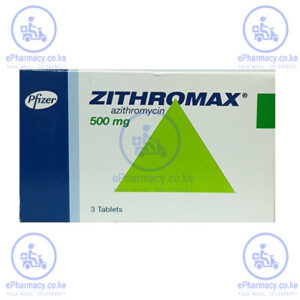Description
Uses and Administration of Azithromycin
AZITHROMYCIN is a macrolide antibacterial with a wide spectrum of activity, that has been used in the treatment of a wide variety of infections caused by susceptible organisms.
Its uses have included bronchitis, severe campylobacter enteritis, chancroid, diphtheria, legionnaires’ disease and other Legionella infections, neonatal conjunctivitis, pertussis, pneumonia (mycoplasmal and other atypical pneumonias as well as streptococcal), sinusitis, and trench fever, and, combined with neomycin, for the prophylaxis of surgical infection in patients undergoing bowel surgery.
In Kenya, AZITHROMYCIN is used as an alternative to penicillin in penicillin-allergic patients with various conditions including anthrax, actinomycosis, leptospirosis, listeriosis, mouth infections, otitis media (usually with a sulfonamide such as sulfafurazole), pelvic inflammatory disease caused by Neisseria gonorrhoeae, pharyngitis, the prevention of perinatal streptococcal infections, rheumatic fever, and infections in splenectomised patients, and staphylococcal and streptococcal skin infections. It has also been used in the treatment of penicillin-allergic patients with syphilis, but there are doubts about its efficacy. In penicillin-allergic patients in the early stages of Lyme disease, AZITHROMYCIN may be used as an alternative to a tetracycline; this use is generally restricted to pregnant women and young children, since it is less effective than other drugs. It is also used as an alternative to the tetracyclines in patients with Chlamydia or Chlamydophila infections (such as epididymitis, lymphogranuloma venereum, nongonococcal urethritis, pneumonia, psittacosis, and trachoma), in Q fever, and in spotted fevers.
Azithromycin may also be used as a component of regimens in the treatment of Mycobacterium avium complex (MAC) infections in Kenya and may be used for prophylaxis. It is used in some countries for the prophylaxis of endocarditis in at-risk patients unable to take penicillin. It is used in the management of trachoma and has been tried in protozoal infections such as toxoplasmosis.
It is given by mouth as the dihydrate; doses are expressed in terms of the anhydrous substance. 524 mg of azithromycin dihydrate is approximately equivalent to 500 mg of anhydrous azithromycin. The capsule formulation should be given at least 1 hour before, or 2 hours after, meals.
The usual adult dose of azithromycin in Kenya is 500 mg as a single dose daily for 3 days. Alternatively, an initial dose of 500 mg may be followed by 250 mg daily for a further 4 days. For the treatment of granuloma inguinale, an initial dose of 1 g followed by 500 mg daily may be given. For uncomplicated genital infections due to Chlamydia trachomatis, 1 g of azithromycin is given as a single dose. A single dose of 2 g has been given for uncomplicated gonorrhoea. For prophylaxis of disseminated MAC infections, azithromycin 1.2 g may be given once weekly. In children over 6 months of age, the dose in the UK is 10 mg/kg once daily for 3 days. In the USA, the dose for children over 6 months of age for pneumonia or otitis media is 10 mg/kg on the first day, then 5 mg/kg daily for a further 4 days (alternatively, 30 mg/kg as a single dose, or 10 mg/kg daily for 3 days may be given for acute otitis media), and the dose for pharyngitis or tonsillitis in children aged over 2 years is 12 mg/kg once daily for 5 days.
Azithromycin dihydrate may also be given initially by intravenous infusion in doses equivalent to 500 mg of azithromycin as a single daily dose in the treatment of community-acquired pneumonia and pelvic inflammatory disease. It may be administered either in a solution containing 1 mg/mL over 3 hours or in a solution containing 2 mg/mL over 1 hour.
Adverse Effects and Precautions
Gastrointestinal disturbances are the most frequent adverse effect but are usually mild and less frequent than with erythromycin. Headache may occur and taste disturbances have been reported rarely. Severe hypersensitivity reactions occur rarely but may be prolonged. Transient reductions in neutrophil counts have been seen in patients receiving azithromycin. Pain and inflammation may occur at the site of intravenous infusions. The UK manufacturers state that azithromycin should not be used in patients with hepatic impairment.
Concurrent administration of Azithrimycin and antacids containing aluminium or magnesium salts can reduce the rate, but not the extent, of absorption of azithromycin; azithromycin should be given at least 1 hour before or 2 hours after the antacid.



Reviews
There are no reviews yet.